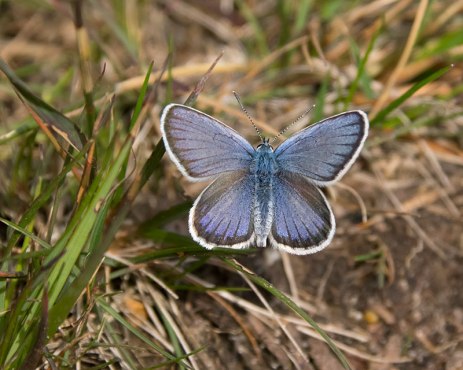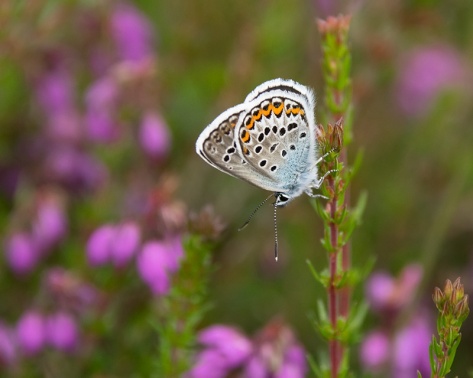
I am stood on a slight rise looking across an undulating scene of heather and gorse. Around my feet blue jewels dance. Once I have seen one, I can see ten, twenty, more. About half of them have iridescent blue upper-wings; the kind of blue that I think only exists in an artist’s imagination until I see these butterflies. The other half are chestnut brown from above. However, when they alight on a heather plant, they all have the most beautiful pattern on their under-wings. To me, it looks like a talented child has drawn their impression of a butterfly’s wings using a set of felt-tip pens, because the spots and lines are so clear and clean. Both the male and females have silvery-blue patches on their hind wings that give them their name, the silver-studded blue.

This butterfly also has a rather incredible life-story. The female lays her eggs on heather, or other similar plants, in relatively sheltered areas. When they hatch, the caterpillars quickly fatten-up by eating these plants. Once they have grown, the caterpillars start to produce a milky secretion that is attractive to black ants (another heath-land specialist). The ants carry the caterpillar into their nests providing it with protection from birds, mammals and reptiles. In the nest, the caterpillar turns into a chrysalis. Peter Marren (2015) writes “One of the most amazing sights of the butterfly world, one discovered only recently, is the emergence from the ant’s nest of a Silver-studded Blue butterfly with anything up to eight ants frantically licking its body. The hour which every butterfly has to spend drying its wings is perhaps the most vulnerable of its whole life. But with a posse of fierce ants to stand guard, the chances of survival are much greater.”
So, silver-studded blues need sunny heath-land sites sheltered by scrub, the presence of black ants, and for the heather to be kept relatively short, for example by rabbits. They also tend to live their entire lives within about 20 metres of the ant-nest from which they emerged, so any damage to that area of heath could wipe out an entire colony.
The UK supports about a fifth of the lowland heath in Europe, but the UK had about 5 times as much lowland heath in the 1800s. Berkshire, where I live, is one of the counties that still has lowland heath, and silver-studded blue butterflies, but it had about 50 times as much lowland heath in the 1800s. This rare habitat is currently given the highest possible level of protection (Bracknell Forest Council, 2018). Although some heath-land restoration has happened in the last twenty years, the pressure on lowland heath in this area remains high.
The best time to see silver-studded blues is on a still warm day during June or July. In perfect conditions, clouds of hundreds of butterflies can be found over a relatively small patch of heather. If you are lucky enough to see one then take the time to inspect it closely.
To improve the prospects of the silver-studded blue butterfly we need to extend the areas of lowland heath adjacent to existing colonies or relocate butterflies to appropriate heath-land with black ants.
Looking at my ordnance survey map, the area in front of me is marked as woodland. With the permission of Natural England and Forestry England, the scrubby wood has been pushed back to the near horizon doubling the area of open heath to the benefit of butterflies, reptiles and ground-nesting birds. However, old photographs show this area being completely treeless over a hundred years ago. This would be very difficult to achieve today as the trees that have grown up in the intervening time are today screening houses, roads and a pheasant shoot.
The decline in silver-studded blue numbers seems to have been halted, but numbers are not yet recovering (https://www.ukbutterflies.co.uk/species.php?species=argus). However, maintaining the open heath is a continual battle which I have written about before (Dear John)
Just beyond where I am stood, the black trunks of gorse bushes growing through the bright green of new gorse and bracken show where a heath fire raged earlier in the year. This fire was probably started by a discarded cigarette and it burnt through about a third of the heather and threatened nearby houses before the fire brigade got it under control. Unfortunately one of the best areas of butterfly habitat was destroyed and with it the ants and the pupae that they were guarding. If this had happened five years ago it might have wiped out the entire butterfly colony, but the expansion of the area of open heath means that there are new areas that the ants and butterflies use from which they can re-colonise the burnt area.
Although fire is one of nature’s mechanisms for stopping heath turning into woodland, in the absence of herbivores with a taste for new gorse and bracken, this area will need human intervention for the heather to return.
I keep coming across the words ‘resilience’ and ‘sustainability’ in various things that I have been working on. I wrote a series of posts about conservation and project management and emphasized the importance of delivering sustainable solutions to conservation problems (Project Managers can save the world). An individual colony of silver-studded butterflies is not resilient to the natural, and man-made disasters, that can affect it’s heath-land home. Multiple colonies across a larger, but connected, area provide more resilience. The silver-studded blue and the heath-land on which it lives are not self-sustaining because of the loss of some of the natural processes that would have made them sustainable in the past.
Is it worth all of this effort to save a little blue butterfly? Any one that has been lucky enough to study this particular species at close quarters, or to share a sandy heath on a warm still day with them, will probably think so.
Thanks again to Dave Braddock for the pictures.
References
Marren, P., 2015. Rainbow Dust: Three Centuries of Delight in British Butterflies. London: Vintage.
Bracknell Forest Council, 2018. Biodiversity Action Plan. [Online] Available at: https://www.bracknell-forest.gov.uk/parks-and-countryside/wildlife/biodiversity-action-plan [Accessed 07 July 2020].
Brilliant blog that puts a spotlight on this beautiful insect. Maintaining their habitat seems very fragile in this turbulent world and articles like this are vital in raising awareness of the dependencies between habitats, flora and fauna. Thanks very much.
LikeLiked by 1 person